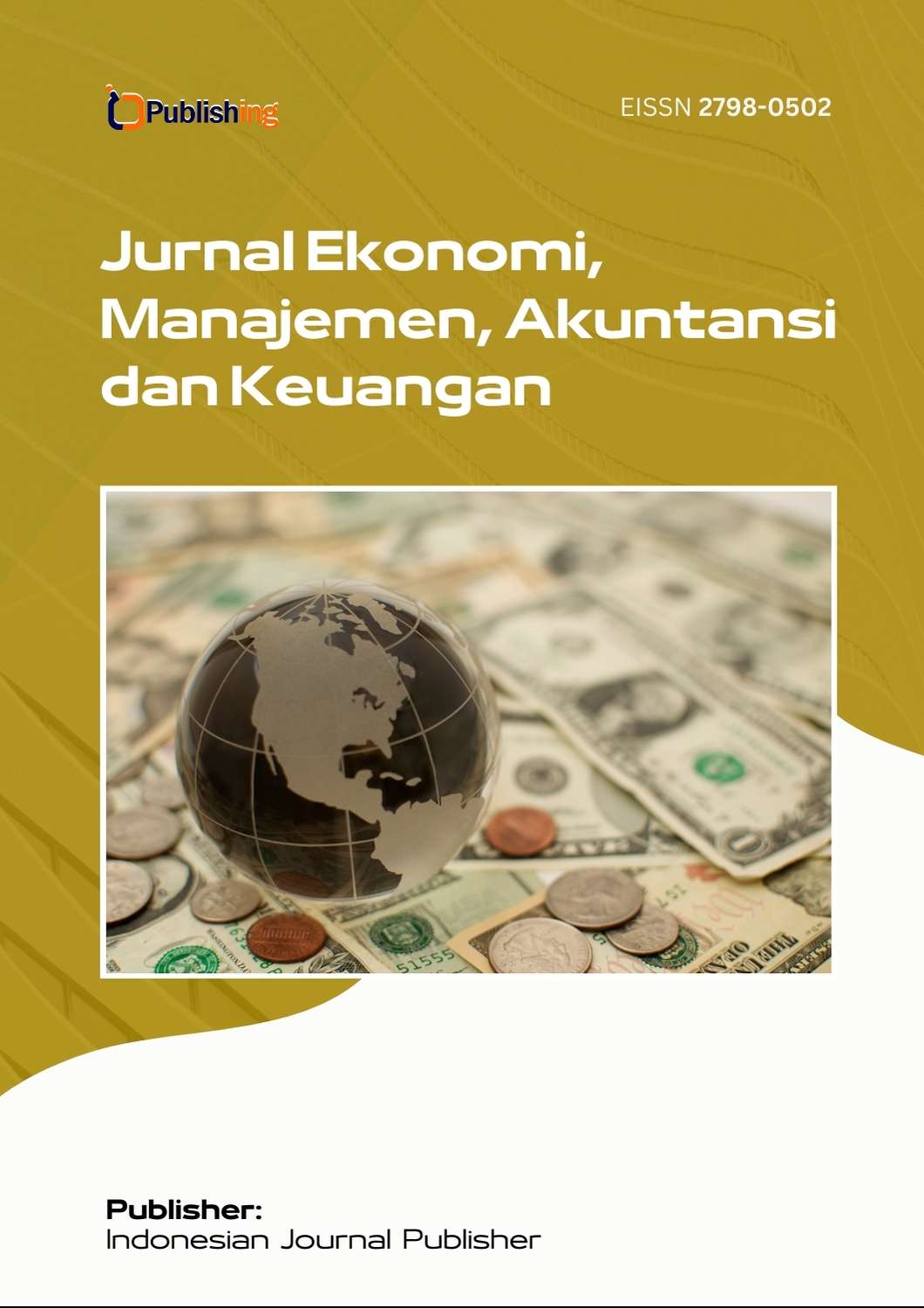Dampak Customer Escapism dan Customer Efficiency Terhadap Rekomendasi Pelanggan Restoran Kelas Atas
DOI:
https://doi.org/10.53697/emak.v6i3.2523Keywords:
Customer Scapism, Customer Efficiency, Positif Word of MouthAbstract
Tujuan penelitian ini untuk mengetahui besaran pengaruh customer escapism dan customer efficiency sebagai bagian pengalaman yang bernilai terhadap penyebaran Word of Mouth yang positif (PWOM) diantara konsumen restoran kelas atas. Penelitian ini mengunakan pendekatan kuantitatif dengan mengambil populasi penelitian para pengunjung restoran kelas atas yang beroperasi di Indonesia. Sampel penelitian digunakan sebanyak 120 sampel dengan kriteria responden yaitu para pelanggan yang telah berkunjung lebih dari satu kali ke restoran kelas atas. Pengujian dan analisa data penelitian dilakukan menggunakan metode analisa statistik berbasis varian memakai perangkat lunak smart PLS-3.0. Hasil penelitian ini menunjukkan pada pelanggan di restoran kelas atas, customer escapism berupa fasilitas bagi pelarian pelanggan untuk mendapat suasana segar, unik, penuh tema dan pemenuhan waktu layanan efektif sebagai perwujudan customer efficiency berpengaruh terhadap penyebaran Positif Word of Mouth yang beredar diantara individu sehingga dapat digunakan sebagai strategi tambahan bagi pengelola restoran guna mengatasi krisis pelanggan.
Downloads
References
Ali, E.-H., & Gaber, A. (2022). Influence of Guest Experience on Word Of Mouth and Revisit Intentions in the Egyptian Hotel Industry. International Journal of Tourism and Hospitality Management, 5(1), 303-320.
Baydeni̇z, E., Çilginoğlu, H., & Valeri, M. (2024). Impact of health tourism visitor experiences on behavioral intention. Journal of Organizational Change Management, 37(5), 1133-1153. https://doi.org/10.1108/jocm-09-2023-0381
Benu, F. L. & Benu, Agus S. (2019) Metode Penelitian Kuantitatif, ekonomi, sosiologi, Administrasi, Pertanian dan lainnya, Pranadamedia Group, edisi pertama, (2019), 35 – 117.
Chin, W. W. (1998). The Partial Least Squares Aproach to Structural Equation Modeling. Modern Methods for Business Research, 295, 336
Creswell, J. W., & Creswell, J. D. (2018). Research design: Qualitative, Quantitative, and Mixed Methods Approaches. In SAGE Publications, Inc. (Fifth Edit). London EC1Y 1SP: SAGE Publications, Inc. https://doi.org/10.4324/9780429469237-3
Fox, G. & Longart, P. (2016). Electronic Word of Mouth: Successful Communication. Tourism and Hospitality Management, 22(2), 211-223
Ghozali, I. (2018). Aplikasi Analisis Multivariate Dengan Program IBM SPSS 25. Semarang: Badan Penerbit Universitas Diponegoro.
Hair, J. F., Jr, Howarda. Matt. C., Nitzlb, C. (2020). Assessing measurement model quality in PLS-SEM using confirmatory composite analysis, Journal of Business Research, Volume 109, March 2020, Pages 101-110
Hair, J. F., Risher, J. J., Sarstedt, Marko, Ringle, Christian. M. (2019) “When to use and how to report the results of PLS-SEM”, European Business Review Vol. 31 No. 1, 2019 pp. 2-24
Hair, J. F., Sarstedt, M., Hopkins, L. and Kuppelwieser, V.G. (2014), “Partial least squares structural equation modeling (PLS-SEM): an emerging tool in business research”, European Business Review, Vol. 26 No. 2, pp. 106-121.
Kim, S., Jeon, D., & Jeon, H. (2021). Well-being perception and lovemarks formation through experiential value in the context of the eco-friendly restaurant. British Food Journal, 123(12), 4264-4283. https://doi.org/10.1108/bfj-02-2021-0136
Kittur, J. (2023). Conducting Quantitative Research Study: A Step-by-Step Process. Journal of Engineering Education Transformations, 36(4), 100–112. https://doi.org/10.16920/jeet/2023/v36i4/2 3120 .
Lo, S. J., Tavitiyaman, P., & Tsang, W. L. (2023). Impact of customers' needs on online information search of upscale restaurant attributes and customer satisfaction. British Food Journal, 126(3), 941-964. https://doi.org/10.1108/bfj-06-2023-0471
Mathwick, C., Malhotra, N. K., Rigdon, E. (2001) Experiential value: Conceptualization, measurement and application in the catalog and internet shopping environment. Journal of Retailing 77(1): 39–56.
Okello, O. V. & Kagendo, S. K. (2024). Influence of Work-Life Balance on Employee Work Performance Among Middle Level Management Public Servants in Public Service in Kenya. European Journal of Theoretical and Applied Sciences, 2(1), 684-687. DOI: 10.59324/ejtas.2024.2(1).59
Onorati, M. G. & Giardullo, P. (2020). Social media as taste re-mediators: emerging patterns of food taste on TripAdvisor. Food, Culture & Society, 23, 347 - 365. https://doi.org/10.1080/15528014.2020.1715074.
Orazi, D. C. & Mannucci, P. V. (2024), Disentangling audiences' reactions to creative content and creative packaging, Strategic management Journals, https://doi.org/10.1002/smj.3649
Outlook Pariwisata dan Ekonomi Kreatif 2023/2024, Kementerian Pariwisata dan Ekonomi Kreatif/Badan Pariwisata dan Ekonomi Kreatif Republik Indonesia
Panchapakesan, P., Amin, M., & Herjanto, H. (2022). How luxury restaurants will enhance the concept of guest delight. Journal of Hospitality and Tourism Insights, 5(2), 311-330. DOI:10.1108/JHTI-10-2020-0198
Pink, S. (2015). Doing sensory ethnography. SAGE Publications Ltd, https://doi.org/10.4135/9781473917057
Ritter, A., Habusha, S., Givon, L., Edut, S., & Klavir, O. (2024). Prefrontal control of superior colliculus modulates innate escape behavior following adversity. Nature Communications, 15(1). https://doi.org/10.1038/s41467-024-46460-z
Sapounakis, E. (2011), Efficiency The Second Essential of a Customer Centric Business, Article No :708 | UX Magazines, Australia
Sayed, M. (2023). The impact of sensory marketing on managing a sustainable fast-food business in egypt. International Journal of Tourism Archaeology and Hospitality, 3(1), 161-174. https://doi.org/10.21608/ijtah.2023.189052.1068
Stasiak, A. (2019). Creating Tourism Experiences — Theoretical Foundations World Scientific Book Chapters, in: Daniela Angelina Jelinčić & Yoel Mansfeld (ed.), Creating and Managing Experiences in Cultural Tourism, chapter 2, pages 17-41, World Scientific Publishing Co. Pte. Ltd.
Sun, X., Li, G., & Marvil, C. (2022). Post covid-19 recovery for independent full-service restaurants using the salience theory: what will it take to get customers to return?. International Journal of Contemporary Hospitality Management, 34(12), 4609-4630. https://doi.org/10.1108/ijchm-08-2021-1005
Taylor, S., DiPietro, R. B., & So, K. K. F. (2018). Increasing experiential value and relationship quality: An investigation of pop-up dining experiences. International Jour- nal of Hospitality Management, 74, 45–56.
Xue, M., & Harker, P. T. (2002). Customer Efficiency. Journal of Service Research, 4(4), 253–267. doi:10.1177/1094670502004004003
Yekanialibeiglou, S. (2015). The influence of dinescape on emotions and behavioral intentions of customers : An upscale restaurant setting. Departement of interior Architecture and environment design, Inhsan Dogramaci Bilkent university, Ankara
Downloads
Published
How to Cite
Issue
Section
License
Copyright (c) 2025 Budi Aryani

This work is licensed under a Creative Commons Attribution-ShareAlike 4.0 International License.










